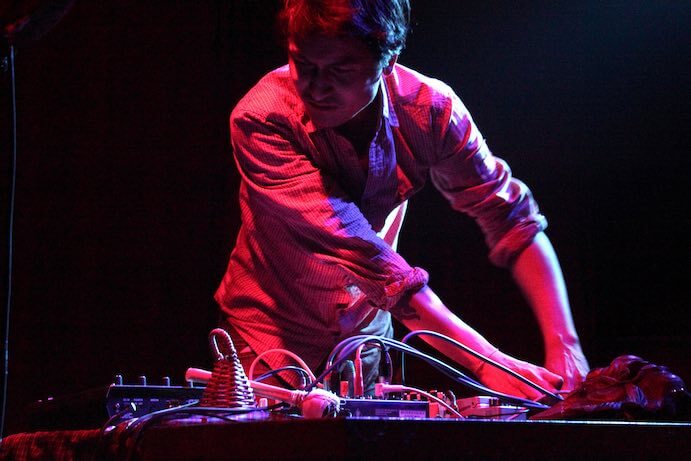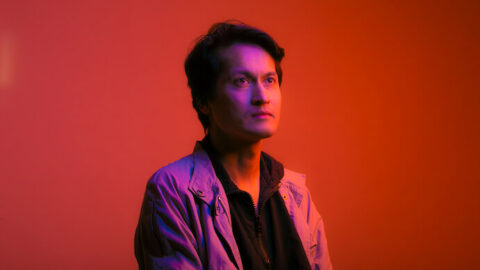People often have a monolithic idea of “Asian music,” and London-based sound artist and conceptual collagist Saphy Vong is on a mission to change that. Vong was born in a Thai refugee camp in Phanat Nikhon to Cambodian parents fleeing the Khmer Rouge. He grew up in France playing in the punk and hardcore scenes before getting into experimental electronic music. As he spent more time in the electronic scene, he noticed a glaring lack of Asian artists and the constant erasure of Asian people’s narratives. So in 2017, Vong founded Chinabot, an experimental label that provides a space for Asian artists to play with their ideas and cultural hybridities across the diaspora. Since its creation, Chinabot has released dozens of albums, garnered praise for its visionary, illuminating unpredictability, and led a change in the dialogue surrounding Asian music.
Chinabot represents a diverse array of DIY artists, and you specifically seek DIY folks over big names. What do your collaborations with these artists look like?
We release DIY artists alongside classically trained musicians. This year, we released material from Bamboo Mystics who received classical musical training, last year we released OHYUNG, who is a film composer, and we are about to release Ayankoko, who has a PHD is jazz guitar but still has a very DIY ethos in the way he works and sees the world. They are really talented and deserve so much more recognition.
The goal of the label since the beginning was to highlight underrepresented artists, and the process is about helping in many ways from mastering to design, press release, and distribution. All the artists I work with need different things, and I try to understand them and respond to what they need. Some artists come with a fully-formed vision, even with designs and masters ready. On the other hand, some releases have had more development in terms of discussions and thinking how to present the release visually.
I often like to work with artists who come from a bit of a niche traditional scene, but have something really creative and experimental which could be brought to a different audience. Other labels prefer to release already famous artists because there is no risk. A lot of labels I used to like have disappointed me recently with less interesting discoveries, focusing more on hype. It’s like a monopoly game in terms of how sales and likes have become almost gamified.
In June, we are celebrating four years of Chinabot with a new compilation. It features a lot of the first artists affiliated with Chinabot as well as new artists. It focuses on the number four, which is bad luck in a lot of parts of Asia. I wanted to have fun with the idea of superstition.
Chinabot’s packaging and visual aesthetic is really striking. Most of your releases include a physical tape (or other physical format) with vivid art and graphic design. It reminds me of the zine/chapbook scene and the tiny press ethos of valuing physical objects. How do you consider the relationship between art and physical objects, and why is that important to your label in the 21st century?
I’m a graphic designer and several Chinabot artists are both sound and visual artists. Arexibo is a photographer, Pisitakun is a multimedia artist, and Jaeho Hwang is a motion designer. When artists are aware of how to represent music visually, it can make the release stronger.
Audio and visual have always been interconnected for me. I was always doing art as a kid, but I’ve never been trained as a musician. I was a teenager when the internet age started. I used to discover music on zines from subculture, radio, or music videos on MTV or Viva. I recorded my rehearsals on tape with my bandmates so we could share it easily, same thing with mixtapes. It’s still nice to buy tapes because they are separate from the unlimited deluge of music on the internet. Having a release which is a finite, standalone object can help the listener value it in and of itself.
As a tape label in the UK, turnaround for making tapes can be really quick since we have a factory here. We also release vinyls, but turnaround is really long and complicated since Brexit since the factories are mostly in Europe, so it’s become really expensive here. Now that England is beginning to reopen, I am starting to encounter how hard it will be in the future to bring Europe-based artists here for performances. It was already hard enough before to bring Southeast Asian artists here, so these further restrictions are a blow for labels like ours which are about trying to link different global audiences.
When I started the label, I was a bit bored of the minimal “white side” of experimental music visually–a bit elitist like in a white gallery. I just wanted to bring some colours. It’s also maybe because my teen life was linked to the 90s rave culture with psychedelic flyers and sounds. It’s very much like magic. Nancy, the city in France where I grew up, also used to be notorious for punk shows in the 90s, so it was quite common to see DIY distribution with tapes, vinyls, and zines. This scene also influenced Chinabot as I was often the only person of colour at these shows. With Chinabot, I want to bring the spirit of this scene to an Asian audience and introduce Asian artists to experimental and DIY audiences, too. But I don’t criticise this digital age–the internet plays a big part in terms of people being exposed to a lot of different things that they otherwise wouldn’t have been exposed to.
I was incredibly moved by your recent album 2562 Neon Flames, which is dedicated to your late mother, Chun Leng. Can you share more about the process of making that?
Thanks for your kind words–it’s my first really personal release. My mother passed away unexpectedly. This album was made like a movie with a special narrative from the beginning to the end. The 12 tracks represent five specific intense days: landing in Cambodia to find out she had already passed away, her cremation, the Khmer New Year celebrations that were happening at the time, spreading her ashes. It’s more about the sum than the individual tracks. It’s a soundtrack to my present reality, cinematic in a way so you can’t stop watching the movie halfway. It was a feeling of an uncontrollable situation, like the contrast between the funeral and the new year celebration. I wanted to express a full range of emotions from beauty to destruction, from calmness to chaotic noise.
My dad was a monk before, and my mum was really Buddhist. It helped me a lot to follow their traditions, and that made its way into the record often with funeral chanting and rhythms which come from temple music.
Your music is raw and risky, on the edge of the future, yet you also draw from centuries-old Cambodian traditions, rituals, and music (such as kantoam ming, smot chanting, etc). How do you honor the past while forging the future?
Running this label and making this music was always risky, that’s why I like it. I think it’s important to evolve. I do think that music sometimes can get a little premeditated in some way.
I don’t think my recent album is futuristic, more nostalgic, but yeah, my vision of the future as a kid became real, so I guess it’s more about the present. I studied the geodesy of Angkor Wat when I made this album, and the vision was really futuristic for the time. Its measurements, orientations, and alignments are near perfect expressions of greater cosmic order, the passage of time, the ever moving rays of the sun, and their influence on agriculture. Moving through history in non-linear ways was important to me, extended to all my inspirations, references, cultures. It’s how I’m representing myself: a fractured experience, it’s complex and nuanced.

I respect traditions and want to give a voice to the present, especially to the younger generation or women that are still really affected by traditions. There is a new law in Cambodia controlling women’s skirt lengths, and sometimes young rappers go to jail for writing lyrics about politics or even poverty in Cambodia. It can be very traditional in a conservative sense, and it feels as though the present moment and social change is not accepted. I’m thinking about the dancers of NCA from Siem Reap, a group of classically-trained Cambodian dancers. They respect traditions and want to explore more with contemporary dance, but the government and culture are not ready. I’m also tired of hearing the same thing about Angkor Wat or the Khmer Rouge linked to Cambodian artists. There is a big international effort on Cambodian archives, but not really on the new music/art scene.
What advice would you give an Asian artist who is just beginning to discover their creative voice?
Be patient, stop comparing yourself with the number of likes on social media, and don’t be scared to take risks. If you are sincere, your music will be heard. People respond to that. Stop thinking too much about money by re-creating whatever is successful at the moment. I think it’s very important that music comes from your heart.
I CARE IF YOU LISTEN is an editorially-independent program of the American Composers Forum, funded with generous donor and institutional support. Opinions expressed are solely those of the author and may not represent the views of ICIYL or ACF.
A gift to ACF helps support the work of ICIYL. For more on ACF, visit the “At ACF” section or composersforum.org.
























